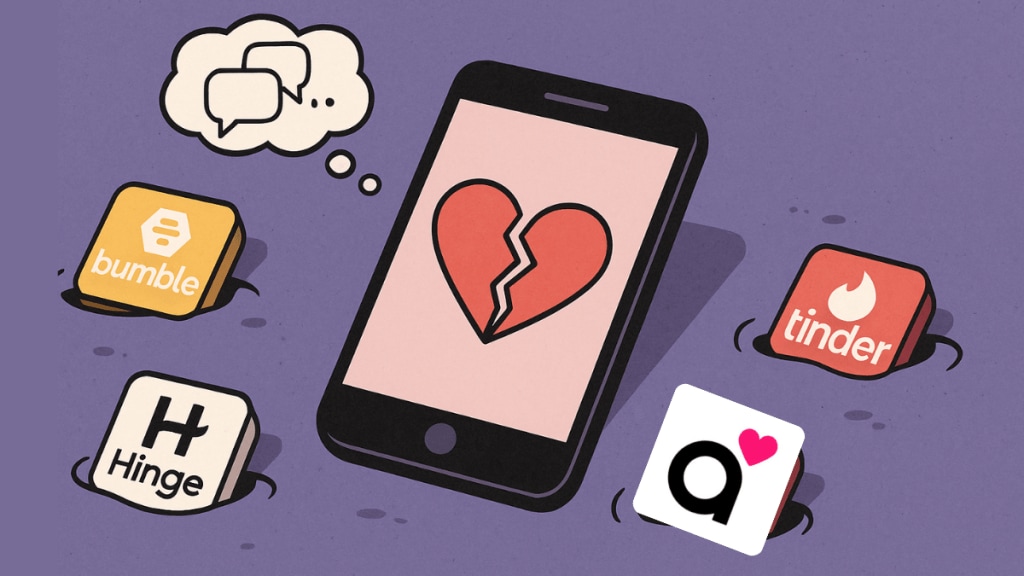For 25-year-old Mamonti, what started as hope for love on dating apps quickly turned into disillusionment. “I joined thinking I’d meet someone genuine, but it just felt like hookup culture everywhere. Most conversations led nowhere or felt transactional. After a point, it felt like I was just another profile to swipe on,” she said.
Once hailed as the future of modern romance, dating apps now find themselves at a crossroads. Tinder’s paid subscribers have fallen for eight consecutive quarters, sliding from 10.9 million in 2022 to 9.6 million last year. Match Group reported a 5% decline in paying users in the first quarter of 2025, as subscriber numbers fell from 14.9 million to 14.2 million in just one quarter. Global downloads of dating apps fell 9% year-on-year in late 2024. With fewer people paying, companies are being forced to act. In May 2025, Match Group cut 13% of its workforce. Bumble followed in June, laying off 30% of its staff as its market capitalisation collapsed from $13 billion at its 2021 IPO to about $720 million today.
“The dating app sector is at a crossroads as user preferences shift towards organic, in-person connections over digital swiping,” Yasin Hamidani, director, Media Care Brand Solutions, told financialexpress.com. He noted that many users are turning away from transactional, algorithm-driven matches in favour of more authentic connections.
So, what’s driving this fall out of favour?
The fatigue is real
For many users, the thrill of the swipe has turned into exhaustion. A 2024 Forbes Health survey found that 78% of dating app users report feeling emotionally, mentally or physically drained by their experience. This isn’t just a Gen X or millennial problem; Gen Z is arguably the most fatigued, with nearly 80% reporting burnout. Users spend, on average, 51 minutes a day on these apps, far more than the 30 minutes experts recommend. And after all that effort? Many report disappointment: 40% say they struggle to find genuine connections, 35% cite disappointment with matches, and 27% feel weighed down by rejection.
Ishita, 28, echoed Mamonti’s frustration. “It’s become mechanical. You swipe, match, and chat for a bit, and then it fizzles out. Or worse, it’s just people looking for validation. It leaves you wondering what’s wrong with you when things don’t progress,” she shared.
“In a culture where relationships are still deeply personal and, yes, sometimes still a family thing, dating apps have become exhausting. Hookup culture— a pattern of short-term, low-investment encounters driven more by instant gratification than meaningful connection, which dominates many of these platforms, often doesn’t align with what a lot of Indian users are actually looking for—emotional connection, compatibility, and some level of seriousness.” Jasreen Birgi, City Lead – Psychologist at LISSUN, a mental health startup, told.
This dynamic can lead to emotional fatigue, rejection sensitivity, and loneliness. Constant swiping can mess with your brain’s reward system, create a toxic sense of comparison, and leave you feeling disposable in a sea of endless options. This abundance of choice often fuels a “disposable mindset,” where potential partners are quickly judged and discarded, leading to a lack of emotional depth and, over time, impacting self-esteem and attachment security, she added.
“A dating app can either look like a clean platform or a hookup site; there’s a thick line between the two. If Tinder is seen in one light, the other won’t work. It’s up to the curator to keep the positioning clear. Positioning is everything.” Harish Bijoor, founder of Harish Bijoor Consults Inc., said.
Where are people going instead?
While the sector may appear to be under pressure, experts point out that the dating market itself remains vibrant. “Dating is absolutely booming in India. It’s really not struggling here at all. What is happening, though, is that the companies with dating apps might be struggling,” Bijoor added. He added that the real issue is intensifying competition as users spread out across multiple platforms.
“If you glance around, you’ve got Tinder, Bumble, Grindr, and probably sixteen other platforms out there. The dating market is just getting super splintered.” Bijoor also noted that platforms like WhatsApp are emerging as significant challengers. “People are making connections through WhatsApp now… WhatsApp groups are probably going to emerge as key competition for the dedicated dating apps,” he said.
Another trend shows that people are going back to the organic ways of meeting potential love interests. Speed dating and singles’ events are making a comeback.
Ruturaj, 26, eventually deleted all the apps. “I was spending so much time on them and coming away feeling worse. There was this sense that no one was serious. I started joining hobby clubs instead; it just feels more real,” he said.
Eventbrite reports a 42% rise in singles’ event attendance between 2023 and 2024, with speed dating specifically up 63%. Running clubs, book-themed meetups, pottery classes, and fitness communities are emerging as the new dating hubs. Even platforms like Instagram are stealing a march on traditional apps: Rizz, an AI dating assistant, found Instagram accounted for 22% of dating-related conversations in 2024, while Tinder and Bumble lagged at 11% and 4%, respectively.
“The post-pandemic revival of social gatherings, community events, and hobby-based meetups has encouraged people to seek authentic connections offline. Additionally, concerns around privacy, safety, and the superficiality of endless scrolling are prompting users to step back from dating apps,” Hamdani said.
The future of love and apps is uncertain
Despite heavy investments in AI, apps are struggling to break the “boredom cycle” of repetitive matches and opaque algorithms. Users want transparency, better compatibility tools, and, increasingly, experiences that go beyond the screen. Niche apps, in-person events, and community-based dating options are filling that gap. The global online dating market is still projected to grow to $17 billion by 2030, but at a much slower pace than before.
Bijoor summed up the challenge ahead: “The core idea of dating definitely continues to rule, but the dating apps themselves just haven’t got their act right yet.”

